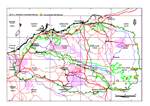Click on images
to enlarge



Photographer: B.R. Maslin

Photographer: J. Maslin

Pruinose mature phyllodes; green new shoots. Photographer: B.R. Maslin
, BRM 5679, ORIGINAL SCAN, ADJUSTED RICHARD WOODMAN_sml.jpg)
Photographer: B.R. Maslin

Photographer: J. Maslin
, BRM 8683, lab photo by Fiona McCallum ADJUSTED_sml.jpg)
Seed from one herbarium voucher. Scale in mm. Photographer: F. McCallum.
Botanical name
Acacia melleodora Pedley, Austrobaileya 1: 205 (1978)
Common name
Scented Wax Wattle
Description
Glabrous, resinous, more or less 'v'-shaped or rounded shrubs 1-3 (-4) m high, dividing at ground level into few to many, spreading-erect, ±straight main stems, the crown sparse to mid-dense. Bark rough at base of oldest stems otherwise smooth and light grey. Branchlets often sparsely tuberculate. New shoots bright green, ±shiny, resinous and slightly sticky or not sticky. Phyllodes obovate to oblanceolate or narrowly oblong-elliptic, Pilbara plants (2-) 3-4 (-5.5) cm long and (4-) 5-10 (-15) mm wide, (1.5-4 (-5.5) cm long and (3-) 4-10 (-15) mm wide over the entire range of the species), smooth, coriaceous to thinly coriaceous, dull grey-green or glaucous, frequently covered with a whitish surface bloom (especially over the nerves) due to dry resin; with 2 or 3 prominent longitudinal nerves and the minor nerves forming an open, net-like reticulum between them; apex obtuse, mucronulate. Gland on upper margin of phyllode 0-2 mm above pulvinus, elongate, an additional smaller gland adjacent to the apical mucro. Inflorescences simple; peduncles 10-20 (-30) mm long; heads globular or obloid, about 10 mm in diameter when fresh (5-7 mm when dry), densely 30-40-flowered, golden, sweet-scented with a faint resinous odour when fresh. Flowers 5-merous; sepals united almost to their apices; buds resinous (but not sticky). Pods usually prolific, oblong to narrowly oblong, flat but raised over seeds alternately on each side, Pilbara plants 3-6 cm long and 9-11 (-13) mm wide (to 9 cm long and 15 mm wide over the entire range of the species), more or less chartaceous, light brown (darker brown over seed), bright green and slightly shiny just before maturity, stipitate at base. Seeds transversely arranged in the pods, widely ellipsoid to ±globose, 3-4 mm long, slightly shiny, brown except pleurogram often bordered by an obscure, narrow band of dull yellow tissue; aril white (drying dull yellow).
Characteristic features
Resinous shrubs. Phyllodes mostly 3-4 cm long and 5-10 mm wide, smooth, dull grey-green or glaucous (green on new shoots), with 2 or 3 prominent longitudinal nerves, the minor nerves forming a relatively fine, open, net-like reticulum between them. Inflorescences simple, heads densely 30-40-flowered, 5-7 mm when dry. Pods oblong to narrowly oblong, broad and flat (mostly 9-11 mm) but raised over seeds alternately on each side, more or less papery, stipitate. Seeds transverse in pods.
Distribution and ecology
Widespread and common in the Western Australian desert areas where it extends from the Pilbara eastwards through central and southern Northern Territory and northwest South Australia to central Queensland. Within the Pilbara, however, it is not especially common; it occurs in the east of the region (principally from near and to the north east of Newman) and from near the Yule River between Port Hedland and Whim Creek (about 300 km northwest of Newman). Grows in deep red or red-brown siliceous sand, on plains, dunes or interdunal areas in spinifex country. Can form dense stands, especially on deep sands associated with dunes.
Flowering and fruiting period
Judging on the limited specimens to hand the Pilbara plants of this species flower from about mid-May to about July (one specimen in flower in September). Pods with mature seeds have been collected in October and judging from these it is probably that mature fruits would extend to November.
Affinities
Very closely related to A. dictyophleba (see that species for discussion).
Notes
Acacia melleodora can resprout from the base following fire although in most instances it is killed.
Chippendale and Jephcott (1963) suggest that A. dictyophleba has moderate nutritive value but is normally not palatable, possibly due to its resinous nature; it is lightly grazed by cattle confined to spinifex country or in extremely dry periods (note: it is probable that these authors' concept of A. dictyophleba also included A. melleodora).
Conservation status
Not considered rare or endangered.
Origin of name
The botanical name is derived from the Latin mellitus (sweet, pertaining to honey) and the Greek odor (smell, scent) in allusion to the sweet-smell emitted by this resinous species, even when dry according to the species author (Pedley 1978). However, the Pilbara plants of this species have no, or very little, resin odour.
References
Chippendale, G.M. and Jephcott, B.R. (1963). Topfeed. The fodder trees and shrubs of Central Australia. Extension Article No. 5. pp. 51. (Northern Territory Administration, Animal Industry Branch: Alice Springs.)
Pedley, L. (1978). A revision of Acacia Mill. in Queensland. Part 1. Austrobaileya 1(2): 75-234.
